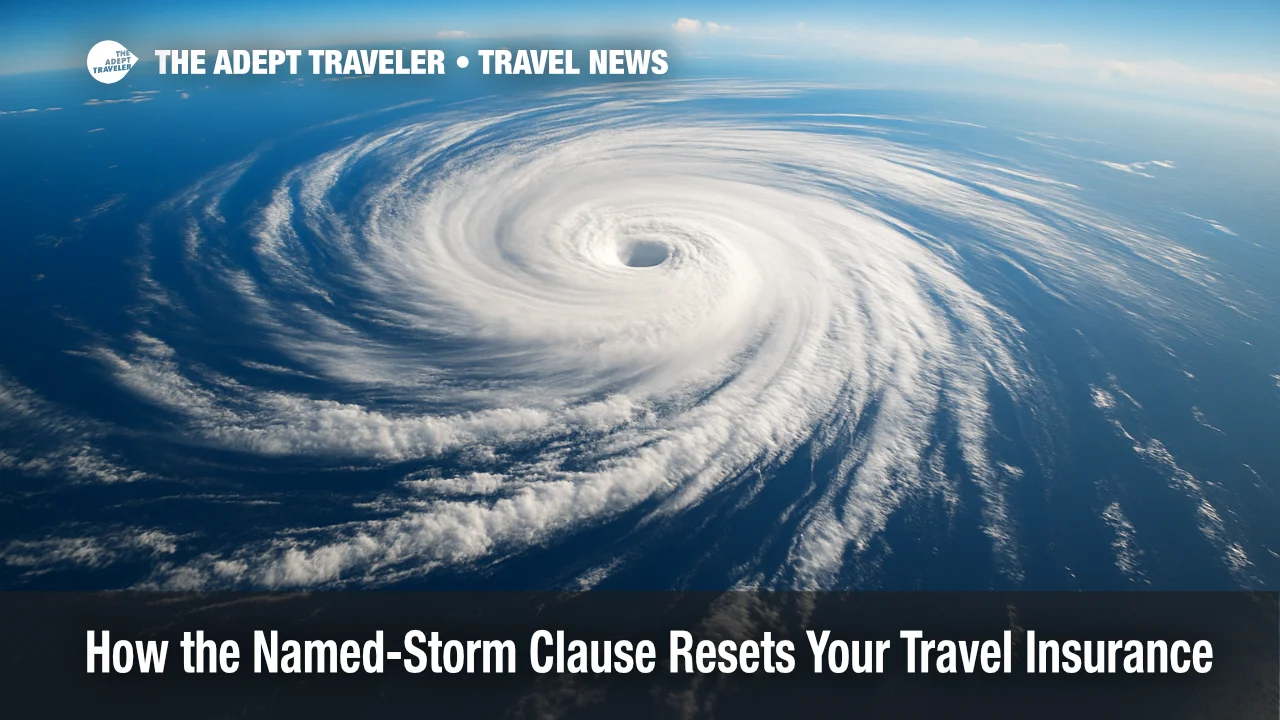How the Named-Storm Clause Resets Your Travel Insurance

Tropical Storms Dexter in the Atlantic and Henriette in the eastern Pacific both earned names on August 4, sealing off storm-related benefits for any travel-insurance policy purchased afterward. The back-to-back designations are a textbook reminder that hurricane travel insurance protects only the unforeseen, and nothing becomes more foreseeable than a storm once the National Hurricane Center names it. Here is what every traveler, cruise guest, and travel advisor should know about the named-storm clause.
Key Points
- Why it matters: Storms become "foreseeable" the instant they are named, ending coverage for late buyers.
- Travel impact: New bookings to Baja, Hawaii, Bermuda, or trans-Atlantic crossings now lack Dexter- or Henriette-related benefits.
- What's next: Policies bought today still cover the next storm, so timing remains critical.
- Insurance bought before August 4 keeps full hurricane benefits for these two storms.
- Cancel For Any Reason upgrades remain an option but cost more and require earlier purchase.
Snapshot
Dexter was first logged by the National Hurricane Center at 03:00 UTC on August 4, about 185 miles north-north-west of Bermuda, while Henriette emerged six hours later 895 miles southwest of Baja California. Because both basins already had active systems, insurers immediately marked the storms as "known events." Under the named-storm clause, any standard policy purchased from that moment forward excludes claims tied to those specific cyclones. Travelers who insured trips on August 3 or earlier keep their hurricane travel insurance in force, but anyone buying on August 4 will need to rely on Cancel For Any Reason coverage-or simply accept the risk. The National Hurricane Center posts advisory archives and live maps for every storm, making the cut-off time easy to verify via its public site (https://www.nhc.noaa.gov/?utm_source=adept.travel).
Background
Most comprehensive travel-insurance plans bundle Hurricane & Weather protection inside Trip Cancellation and Trip Interruption benefits. That protection hinges on two conditions: the policy must be purchased before the storm is named, and the destination must become uninhabitable, inaccessible, or be under an official evacuation order. Insurers lean on National Hurricane Center bulletins to define when a storm is named and when watches or warnings are issued. Leading brokers such as Squaremouth note that a storm turns "foreseeable" the instant it receives a name, after which related claims are barred. Allianz and Travel Guard emphasize buying coverage soon after the initial trip deposit-preferably at least 24 hours before any potential naming. For travelers who booked Baja cruises or Los Cabos stays on August 5, Henriette is already excluded, but the policy will still respond to Ashley or future storms that have yet to form. (For a Henriette-specific booking timeline, see our insurance-clock reset advisory.)
Latest Developments
Dexter and Henriette Set the 2025 Benchmark
Dexter is the Atlantic's fourth named storm of 2025, while Henriette is the eighth in the eastern Pacific. Although neither threatens land at this time, cruise lines have begun adjusting great-circle routes between Japan and Alaska and evaluating Mexican Riviera itineraries that venture near the storms' projected swell zones. Airlines, too, are monitoring potential long-haul schedule tweaks. Insurance providers have issued position statements freezing coverage for both events. Generali, for example, lists each storm's advisory number and timestamp so travelers can match purchase dates against eligibility. Brokers report a surge in "panic buys" of Cancel For Any Reason plans, which remain valid so long as they are purchased within 14 days of the initial trip payment and at least 48 hours before departure. Expect another reset the moment the season's next storm earns a name, restarting the countdown for fresh bookings.
Analysis
Named-storm timing is everything. Once Dexter and Henriette appeared on the National Hurricane Center board, they entered insurers' databases as "known losses." That classification removes the unpredictability on which insurance is predicated. The clause applies per storm, per policy: it does not wipe out hurricane travel insurance entirely, but it does bar claims linked to that storm's effects-flight cancellations, port closures, hotel damage, or evacuation orders-if the policy was purchased too late. Travelers still gain valuable protections for medical emergencies, lost luggage, or later storms, yet many do not realize the gap until a claim is denied. Cancel For Any Reason offers a workaround but only reimburses about 50 to 75 percent of pre-paid costs and demands stricter purchase windows. Advisors should coach clients to insure trips the same day they drop the first deposit, reinforcing the discipline ahead of peak hurricane season. Doing so keeps hurricane travel insurance intact, locks in supplier default coverage, and avoids sudden premium hikes once a cyclone forms. Dexter and Henriette are simply August's warning shot that the named-storm clause is alive and well.
Final Thoughts
Hurricane season rewards early birds. Dexter and Henriette prove that a single advisory can erase storm benefits for thousands of late buyers, leaving only pricey Cancel For Any Reason options. If your vacation falls between June 1 and November 30, insure it the day you book, double-check storm names, and keep an eye on the National Hurricane Center. That vigilance is the surest way to stay ahead of the next named-storm clause reset. Named-storm clause.
Sources
- Tropical Storm Dexter Advisory #1, National Hurricane Center
- Tropical Storm Henriette Advisory #1, National Hurricane Center
- Hurricane & Weather Travel Insurance Coverage, Squaremouth
- Hurricanes and Travel Insurance Coverage, Travel Guard
- Hurricane Travel Insurance Changes After Storm Is Named, InsureMyTrip
- When a Hurricane Hits, What Does Travel Insurance Cover?, Allianz Global Assistance
- Tropical Storm Henriette Forms in the Pacific While Dexter Churns in the Atlantic, Associated Press
